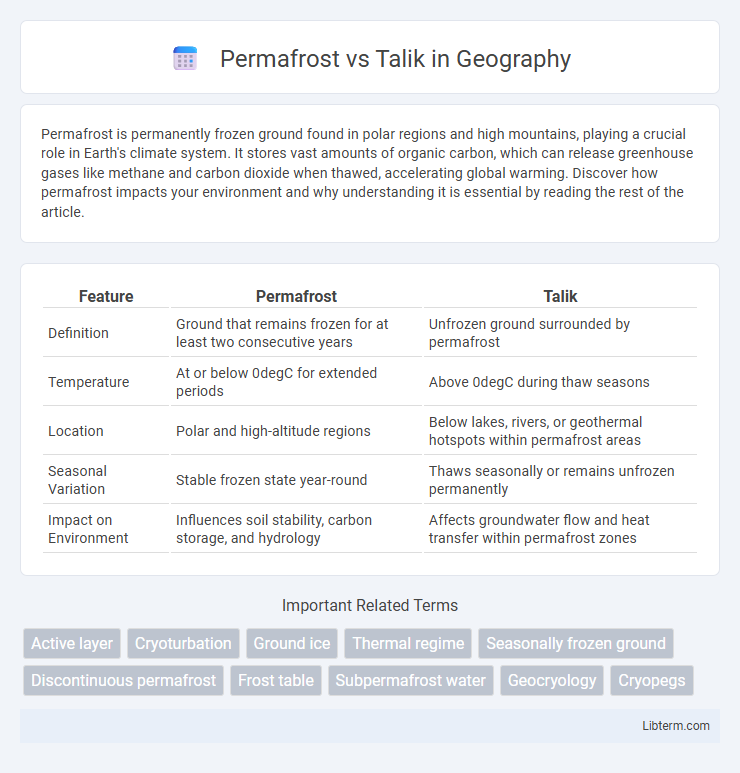Permafrost is permanently frozen ground found in polar regions and high mountains, playing a crucial role in Earth's climate system. It stores vast amounts of organic carbon, which can release greenhouse gases like methane and carbon dioxide when thawed, accelerating global warming. Discover how permafrost impacts your environment and why understanding it is essential by reading the rest of the article.
Table of Comparison
| Feature | Permafrost | Talik |
|---|---|---|
| Definition | Ground that remains frozen for at least two consecutive years | Unfrozen ground surrounded by permafrost |
| Temperature | At or below 0degC for extended periods | Above 0degC during thaw seasons |
| Location | Polar and high-altitude regions | Below lakes, rivers, or geothermal hotspots within permafrost areas |
| Seasonal Variation | Stable frozen state year-round | Thaws seasonally or remains unfrozen permanently |
| Impact on Environment | Influences soil stability, carbon storage, and hydrology | Affects groundwater flow and heat transfer within permafrost zones |
Introduction to Permafrost and Talik
Permafrost refers to ground, including soil or rock, that remains continuously frozen for two or more consecutive years, primarily found in polar regions and high-altitude areas. Talik is unfrozen ground located within or beneath permafrost layers, often acting as a thermal buffer and influencing hydrological and geotechnical properties. Understanding the interaction between permafrost and talik is critical for assessing climate change impacts, infrastructure stability, and ecosystem dynamics in cold environments.
Defining Permafrost: Characteristics and Formation
Permafrost is defined as ground that remains continuously frozen for two or more consecutive years, typically found in polar regions and high-altitude environments. It is characterized by its ice-rich soil and rock composition, which significantly influences the thermal and hydrological properties of the terrain. Formation of permafrost occurs when mean annual air temperatures remain below freezing, causing the ground to freeze and maintain this frozen state year-round.
What is Talik? Key Features Explained
Talik is a layer of unfrozen ground that lies beneath permafrost or between two permafrost layers, remaining thawed throughout the year due to geothermal heat and insulation from surface temperature extremes. Key features of talik include its role as a thermal buffer allowing groundwater flow, its common presence in discontinuous permafrost zones, and its impact on permafrost stability and ecosystem hydrology. Taliks are critical in understanding climate change effects on permafrost regions, as their expansion influences carbon release and local infrastructure integrity.
Comparing Permafrost and Talik: Core Differences
Permafrost refers to a permanently frozen layer of soil or rock that remains below 0degC for at least two consecutive years, whereas talik is an unfrozen zone that exists within or beneath permafrost. The core difference lies in their thermal state: permafrost is continuously frozen, while talik remains thawed due to factors such as geothermal heat or the insulating effect of overlying water bodies. Talik often forms beneath lakes or rivers where the thermal insulation prevents freezing, creating a localized thawed area in an otherwise frozen terrain.
Geographic Distribution: Where Are Permafrost and Talik Found?
Permafrost is predominantly found in high-latitude regions such as Siberia, Alaska, northern Canada, and parts of Greenland, covering vast areas of the Arctic and sub-Arctic zones. Talik occurs in areas where the ground remains unfrozen beneath lakes, rivers, or insulation layers within continuous or discontinuous permafrost regions, commonly seen in Siberian and Canadian permafrost landscapes. The spatial distribution of permafrost and talik is closely linked to climatic conditions, with permafrost forming in consistently cold environments and talik zones developing in localized thawed pockets.
Thermal Regimes: Temperature Dynamics in Permafrost and Talik
Permafrost maintains subzero temperatures year-round, preserving frozen ground layers crucial for Arctic ecosystems and infrastructure stability. In contrast, talik features unfrozen zones within or beneath permafrost, characterized by positive temperature anomalies that disrupt thermal continuity and influence subsurface hydrology. Temperature dynamics in these contrasting thermal regimes significantly affect carbon release, microbial activity, and permafrost degradation rates in cold environments.
Environmental Impacts of Permafrost and Talik
Permafrost stores vast amounts of organic carbon, and its thaw releases greenhouse gases like methane and carbon dioxide, accelerating climate change. Talik, the layer of unfrozen ground beneath or within permafrost, acts as a pathway for heat and water, influencing permafrost degradation and altering hydrological systems. Both permafrost thaw and talik expansion disrupt ecosystems, increase soil instability, and impact infrastructure in Arctic and sub-Arctic regions.
Influence on Ecosystems and Hydrology
Permafrost creates a stable frozen ground that limits water infiltration, preserving unique cold-adapted ecosystems and controlling surface hydrology by restricting groundwater flow. Talik, an unfrozen layer within or beneath permafrost, enhances subsurface water movement, altering thermal regimes and promoting nutrient exchange that supports diverse plant and microbial communities. The presence of talik affects wetland formation and can increase greenhouse gas emissions through thaw-induced microbial activity, impacting regional hydrology and ecosystem dynamics.
Climate Change Effects on Permafrost and Talik
Permafrost, permanently frozen ground found in polar regions, is increasingly thawing due to rising global temperatures, leading to the expansion of taliks--unfrozen zones within or beneath permafrost layers. Climate change accelerates the degradation of permafrost, releasing stored greenhouse gases such as methane and carbon dioxide, which further intensify warming and promote talik development. The growth of taliks disrupts soil stability and ecosystem dynamics, posing risks to infrastructure and amplifying climate feedback loops in Arctic environments.
Future Research and Monitoring of Ground Thermal States
Future research on permafrost and talik emphasizes advanced remote sensing technologies and high-resolution ground temperature models to improve prediction accuracy of ground thermal regimes. Monitoring networks combining borehole temperature data and geophysical surveys aim to detect temporal changes in permafrost thickness and talik expansion under rising global temperatures. Integrating machine learning algorithms with in situ data enhances early-warning systems for infrastructure risks linked to permafrost degradation and talik development.
Permafrost Infographic

 libterm.com
libterm.com